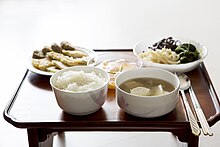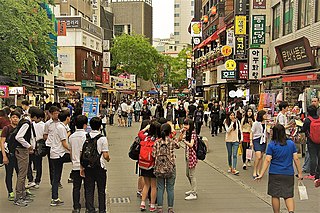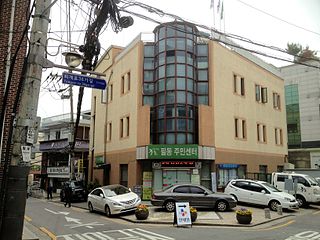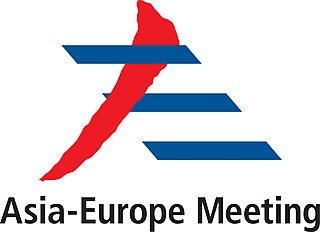
Kimchi fried rice or kimchi-bokkeum-bap (김치볶음밥) is a variety of bokkeum-bap, a popular dish in Korea. Kimchi fried rice is made primarily with kimchi and rice, along with other available ingredients, such as diced vegetables or meats like spam.

Kimchi-jjigae (김치찌개) or kimchi stew is a jjigae, or stew-like Korean dish, made with kimchi and other ingredients, such as scallions, onions, diced tofu, pork, tuna and seafood. It is one of the most common jjigae in Korea.

Starfield COEX Mall, containing COnvention centers, EXhibition halls and many malls, is an underground shopping mall in Gangnam-gu Seoul, South Korea. It has an area of about 154,000 square metres, of which 144,000 square meters are on a single underground floor, making it the world's largest underground shopping mall. The mall is located at Samseong-dong served by Samseong Station on Seoul Metro Line 2, at the intersection of Teheranno and Yeongdong Dae-ro. The COEX Mall is adjacent to the COEX Convention & Exhibition Center, which is part of the COEX complex, run by the Korea International Trade Association (KITA).
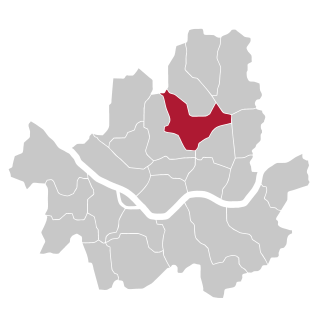
Seongbuk District (Seongbuk-gu) is one of the 25 gu which make up the city of Seoul, South Korea. It is located in the mid-north part of the city. The current Mayor is Kim Young-bae (김영배), who has been mayor since July 1, 2010.

Dongdaemun District is one of the 25 districts of Seoul, South Korea.

Dongchimi is a variety of kimchi consisting of Korean radish, napa cabbage, scallions, pickled green chilli, ginger, Korean pear and watery brine in Korean cuisine. As the name dong and chimi, suggests, this kimchi is traditionally consumed during the winter season.

Dongdaemun Station is a station on the Seoul Subway Line 1 and Line 4. It is named after one of the four great gates of the circular wall surrounding ancient Seoul, and is situated on the eastern end of Jongno. This station is also close to Dongdaemun Market.

Ilmin Museum of Art is a private art museum of South Korea, located on Sejongno street in Jongno-gu, a central district of Seoul, known for exhibiting mainly Korean art. The museum was established and run by the Ilmin Cultural Foundation (일민문화재단), a non-profit organization founded in 1994 in memory of Kim Sang-man, former president of Dong-A Ilbo, one of the major newspaper companies of South Korea. Kim devoted his entire life to developing Korean journalism and promoting Korean culture. The museum is named after his pen name, "Ilmin".

Tteok Museum is a museum located in Waryong-dong, Jongno-gu, Seoul, South Korea. Founded by Yoon Sookja, the chief director of the Institute of Traditional Korean Food (한국전통음식연구소), it opened in December, 2002. The museum specializes in Korean cutlery with approximately 2,000 old Korean kitchen utensils from ancient maetdol to early 20th century kitchenwares on display and exhibits 50 of Korea's nearly 200 types of tteok.

Samseong-Dong is an affluent neighborhood or ward of Gangnam-gu in Seoul, South Korea.

Hyehwa-dong is a dong, neighbourhood of Jongno-gu in Seoul, South Korea.
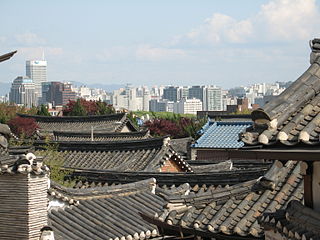
Bukchon Hanok Village is a Korean traditional village in Seoul with a long history located on the top of a hill between Gyeongbok Palace, Changdeok Palace and Jongmyo Royal Shrine. The traditional village is composed of lots of alleys, hanok and is preserved to show a 600-year-old urban environment.

A ttukbaegi (뚝배기) is a type of oji-gureut, which is an onggi coated with brown-tone ash glaze. The small, black to brown earthenware vessel is a cookware-cum-serveware used for various jjigae (stew), gukbap, or other boiled dishes in Korean cuisine. As a ttukbaegi retains heat and does not cool off as soon as removed from the stove, stews and soups in ttukbaegi usually arrive at the table at a bubbling boil.
Korean regional cuisines are characterized by local specialties and distinctive styles within Korean cuisine. The divisions reflected historical boundaries of the provinces where these food and culinary traditions were preserved until modern times.
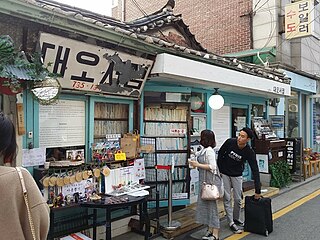
Seochon (서촌) is one of the oldest neighborhoods of Jongno-gu in northern Seoul, South Korea. It translates as "West village" or "Western village" as it is west of the Gyeongbok Palace. It is also thought that the name could have derived from Mt Inwangsan as the mountain used to be called "Seosan" or "old mountain in the west." Seochon is traditionally associated with the Joseon dynasty and Korean literature.

